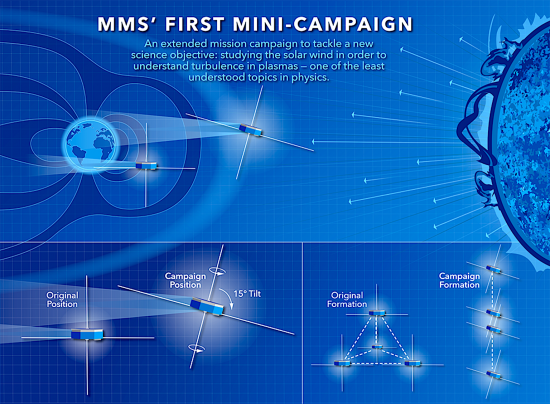
Aug 12, 2019
The Sun shocks the Solar System.
Not in the way that astronomers think, however. Instead of “shockwaves” racing by the planets, it is electric shocks that are detected.
The Magnetospheric Multiscale satellites were launched March 12, 2015 on a mission to study Earth’s electromagnetic fields. The MMS constellation, as well as the Geospace Electrodynamic Connections mission and the Magnetospheric Constellation mission, are part of a widespread, international consortium known as the Global Electric Circuit Project.
The MMS constellation, along with TIMED, Cluster, ARTEMIS, and other satellites, is analyzing the Sun’s influence on Earth’s thermosphere, about 100 kilometers in altitude. The solar wind of charged particles first interacts with atmospheric particles in the thermosphere. However, that region is not well understood, especially since TIMED detected a tenfold decline in the thermosphere’s temperature since 2002.
According to a recent press release, MMS found what heliophysicists call a “collisionless” shockwave in the solar wind. The solar wind is comprised of two types of emissions: the fast solar wind and the slow solar wind. It is believed that when the fast solar particle stream overtakes the slow stream, it initiates a shockwave, just like compression waves in air. However, the solar wind is so diffuse that particles rarely (if ever) collide with one another, so electromagnetism is invoked, although it is not thought of as an electrical effect.
A recent Picture of the Day highlighted the electrical nature of the Sun’s interaction with the Solar System. Astrophysicists think that “turbulence” causes variability in the solar wind, as well as its anomalously high temperature. So, two of the solar wind’s most important aspects, its high temperature and acceleration, are said to be from kinetic effects, and that attitude is carried over into the new press release.
The movement of electric charges in plasma forms electromagnetic fields that constrict the current. As previous Picture of the Day articles point out, the constricted channel is known as a “Bennett pinch,” or “z-pinch.” The pinched electric filaments remain coherent over long distances, forming helical structures that can transmit power through space. That phenomenon is what scientists refer to as flux ropes. They also create electromagnetic structures called “plasmoids”.
Electric fields freely accelerate charged particles, which move outward in opposite directions, activating an electric current that follows the Sun’s magnetic field. The THEMIS satellites found “space tornadoes” (Birkeland currents), electrified plasma vortices rotating faster than 1,600,000 kilometers per hour, about 64,000 kilometers from Earth. The THEMIS satellites, together with Earth-based stations, verified that those charged plasma formations are connected to the Sun.
In conclusion, electricity stares at astronomers from the Sun, but they are too blinded by its light to understand.
Stephen Smith
The Thunderbolts Picture of the Day is generously supported by the Mainwaring Archive Foundation.












